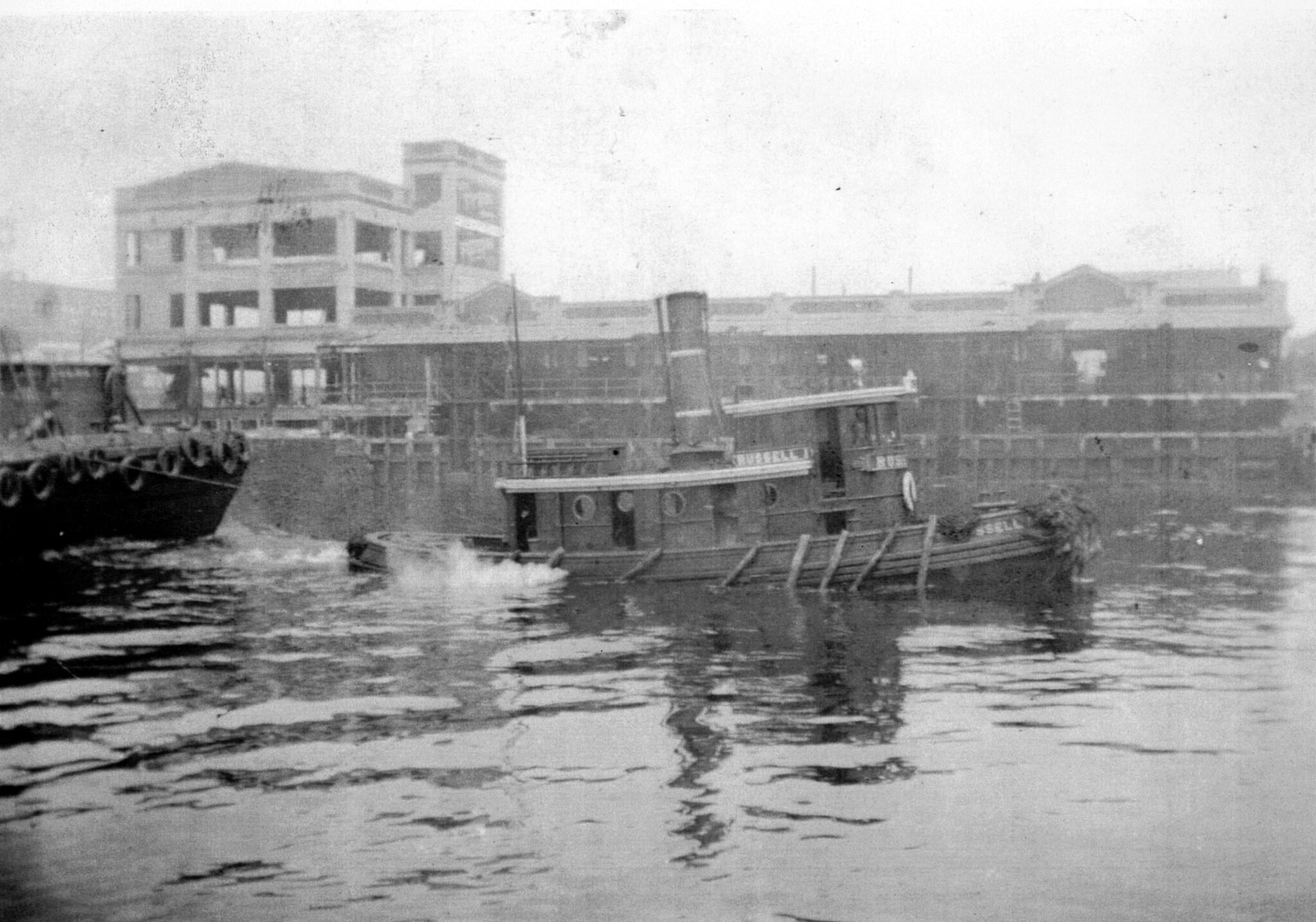William Oscar Decker, built by the Russell Dry Dock Company
A Seaport Museum Blog
by Ryan B. Witte, Visitor Experience Associate
November 17, 2022
This past September, the Visitor Experience Team at the Seaport Museum was invited to tour The Newtown Creek Wastewater Treatment Plant in Brooklyn. I had been there in 2017 for Open House New York and thought it was fascinating. I was pleased to return for a closer look. Since this waterway was the birthplace of the Museum’s adorable tugboat W.O. Decker, I thought this would be a great opportunity to learn more, place Decker firmly within the Russell family’s fleet, and place their boats firmly into the context of the creek where they operated.
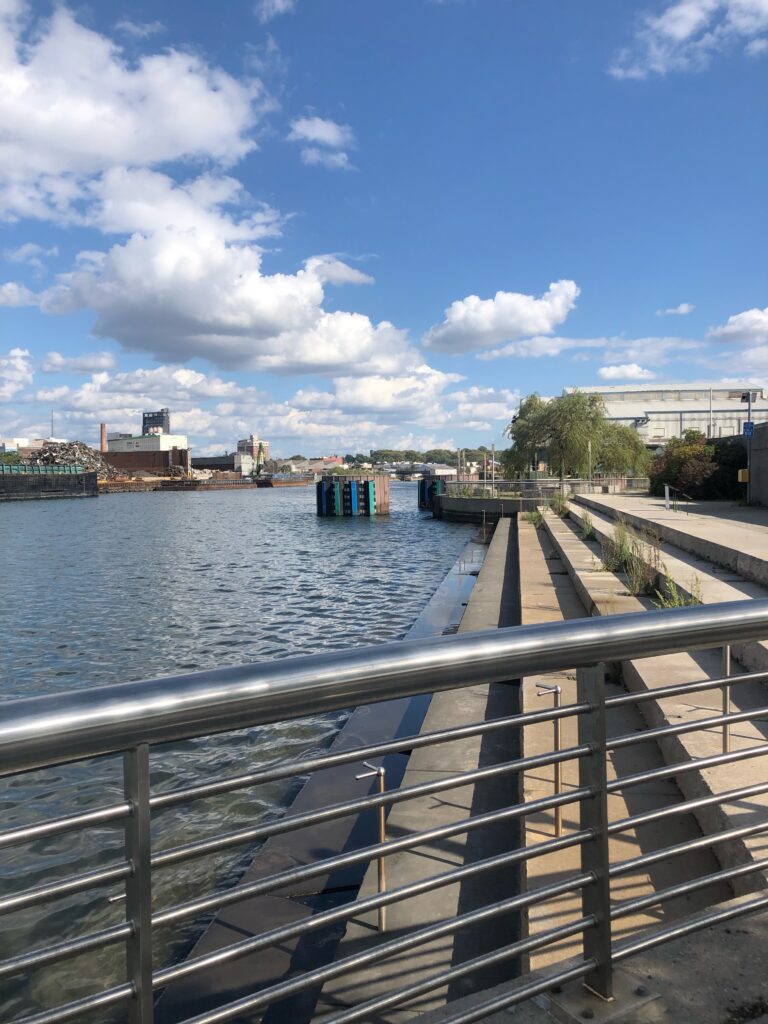
After our tour of the plant, we were encouraged to explore the path around the creek next to it. The first section of this new Nature Walk opened in 2007, designed by Quennell Rothschild & Partners and environmental artist George Trakas. Additions were made to it in 2014 and 2021. Rothschild & Partners have designed numerous landscapes around the city, including the Peck Slip Park (2021) two blocks north of the Seaport Museum, the Lower Broadway Streetscape (2004), interventions at Battery Park, and landscaping for the Statue of Liberty Museum (2017). Artist George Trakas (b. Quebec City, 1944) is known for a fairly visible project: three sculptures, “Hook,” “Line,” and “Sinker,” (2004) visible in the Atlantic Avenue—Barclays Center subway station in Brooklyn.[1] “Artwork: ‘Hook,’ ‘Line,’ and ‘Sinker,’” Subway Art Guide, Line by Line Guide, NYCSubway.
The Nature Walk is a truly inspiring work of landscape design that tells a complete story of this waterway by engaging multiple senses. It begins at Paidge Avenue, lined by trash cans shaped like wooden barrels, a reference to the barrel-making shops once prevalent in the neighborhood.[2]Flyer: “The Newtown Creek Nature Walk,” NYC Department of Environmental Protection
Photo by Visitor Experience staff member Tim Hughes.
A small garden focusing on fragrant plants is tucked under a staircase and a ramp leading up over a boat-shaped bridge called “The Vessel.” This is made from board-formed concrete that leaves a wood grain texture on its surface. On the other side, a gentle slope leads back down to the creek’s shore, with a channel running down the center, calling one’s attention to rainwater that flows into the creek.
This winds past a small cluster of tables carved with words in the Lenape Natives’ language, Munsee. If one stands directly in front of these place names in order to read them, the body will automatically be facing the landscape element the word describes. This section helps to frame a flight of granite stairs leading directly to the water, etched with the terms for eras in geology and biology, and carved out with a number of small triangular recesses that host oysters in pools of water below and native plants higher up. While we sat there, several geese came over to see what was going on, occupying the stairs twelve feet or so away from us for about a minute before swimming off again.
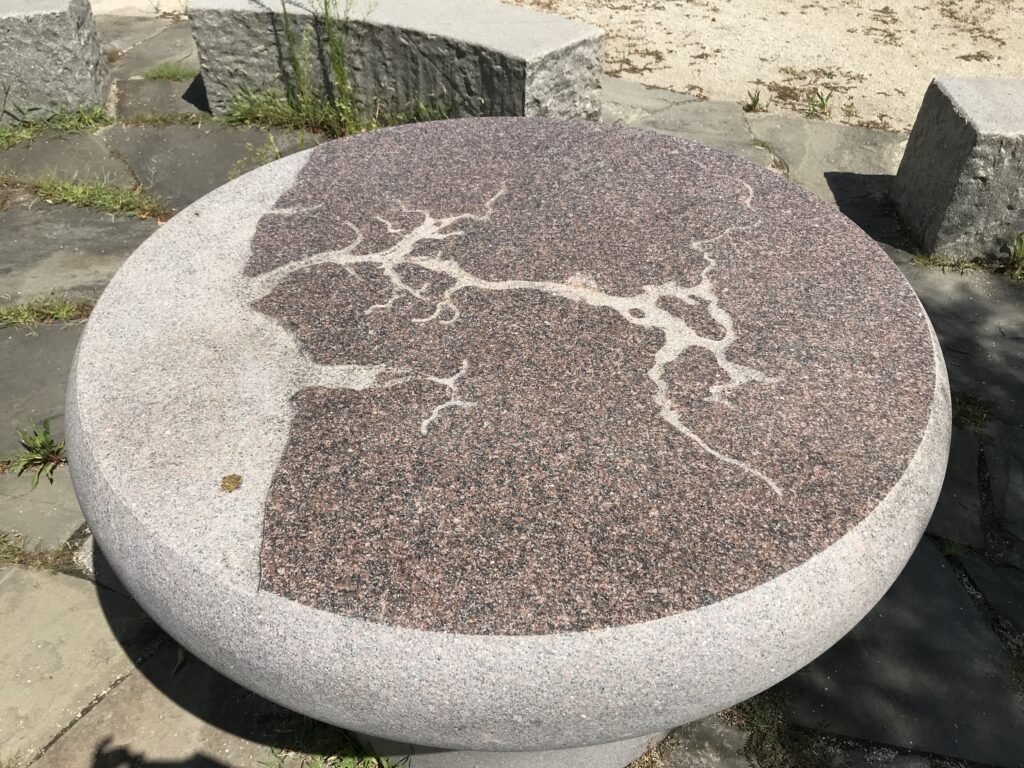
Photo by the author.
At the eastern end of this section, under two weeping willow trees is a grouping of benches surrounding a 1,400-pound granite bollard etched with the outline of the Newtown Creek watershed in its natural state before human meddling. Over the years, its contours had been altered to make it more easily navigable and to align with the surrounding street grid. A small brass pin can be felt by fingertip to indicate the location of the bollard. Water poured over top of it can illustrate how it flows out into the East River at real life scale.
Out in the real waterway are three large bumpers to catch vessels rounding this corner into Whale Creek, a short branch that extends off the main part of Newtown and heads south. This longer meandering section of path focuses mainly on the various plant species––best diet for the geese, incidentally––which are labeled with even their medicinal and other uses noted, and several small nooks that allow a visitor to descend to the water’s edge.
Rounding a slight bend in Whale Creek, one boards in succession three boat-shaped bridges lined with scientific terms following the march of human civilization in relief on their gunwales or top edges. The first and third of these are planked with wood, while the middle one is floored in heavy metal grates allowing a view down to the water, and are not bolted firmly to the bridge structure. Walking across these metal sections is not only tactile underfoot, but also audible. The weight of a human footfall causes a metallic clang that recalls the area’s industrial activity. Turning eastward, one crosses one last steel truss bridge.
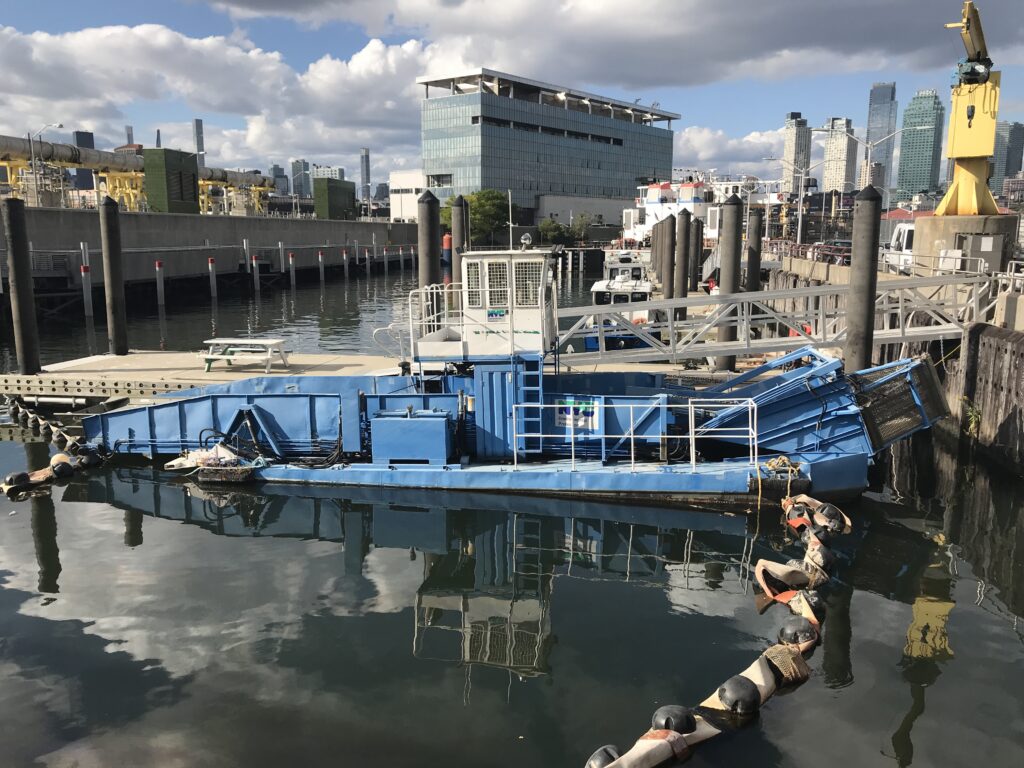
Surface Skimmer Ibis at the terminus of Whale Creek with vessel-shaped bridges in the background. Photo by the author.
The boat-shaped bridges serve to draw one’s attention to the actual vessels that are moored along the waterway, four of which we saw that day are part of the City of New York’s fleet. The largest of them, the (remarkably clean) 2014 waste disposal vessel Hunts Point was pulling in as we walked along next to her. The Department of Environmental Protection Marine Operations 2019 Tide Runner was next, then their 1999 Oystercatcher, and finally their 1999 Skimmer Vessel Ibis, for gathering up trash found floating on the creek’s surface.
The following section, the third phase, is probably the most remarkable. First is a picnic table sheltered by an upside-down boat hull, with a depiction of the U.S.S. Monitor carved into the table top. The Monitor was famously built at nearby Continental Iron Works in 1862, and went on to play a decisive role in the Battle of Hampton Roads during the American Civil War. Contrary to popular conception, she was not notable as much for being clad in iron, but for being one of the first warships to have a rotating gun turret.
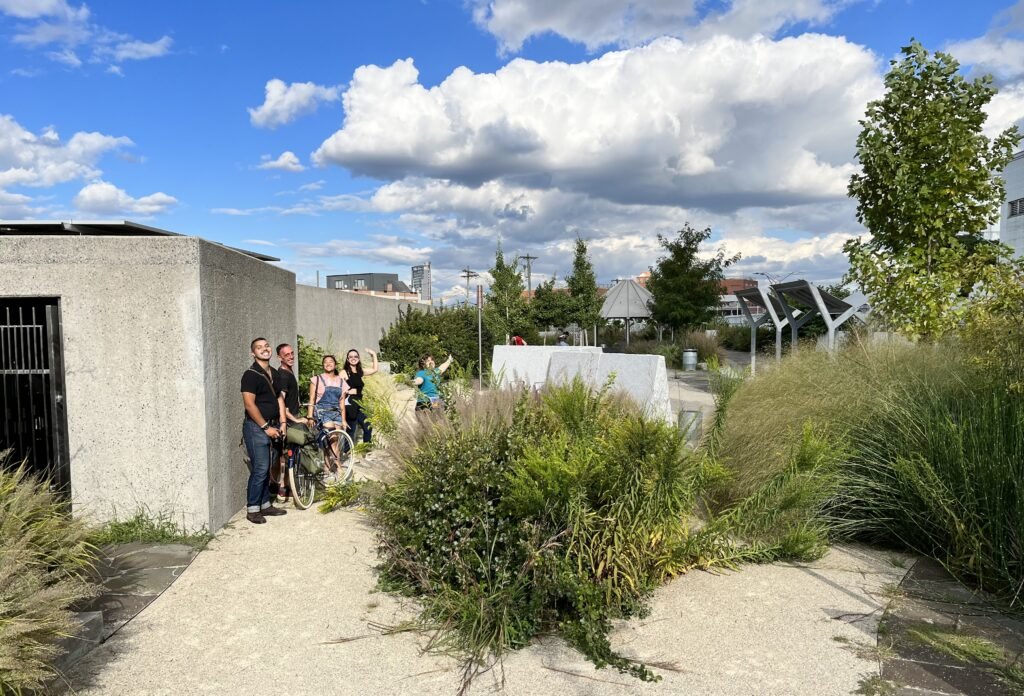
Next to this is a rain garden––which is fed by a channel similar to the one in the first section, so that rain run-off is naturally filtered by the plants before pouring into the waterways––a small footbridge crosses over this allowing it to be seen more clearly. Aside from the discomfort of getting wet, the nature walk could be easily as fascinating in a rainstorm as in sunny weather.

On the south side of the little bridge are solar-powered seats showing stars used in navigation that light up when you sit on them.
To the north is a small grove with boulder-sized fossilized tree trunks around 385-million-years-old and sea creatures embedded in rock.
Photos by Visitor Experience staff member Janet Spiller.
Further on is a circular shelter with a water fountain at its center and an oculus in the roof. Leading to this water fountain, one of many lining the walkway, are a pair of bare footprints and a pair of booted footprints imprinted into the cement floor. After another hundred feet or so, the Nature Walk ends at Kingsland Avenue.
The only thing that could make this project more brilliant is for it to continue winding its way around the shoreline of the entirety of Newtown Creek over the years to come.[3]Note should be made of SWA Group’s masterpiece Hunter’s Point South Waterfront Park, approaching from the Queens side. It seemed fortuitous that the tour invitation would come from a major landmark on the waterway where the Museum’s tugboat operated, as it was also a great opportunity to look deeper into her origins.
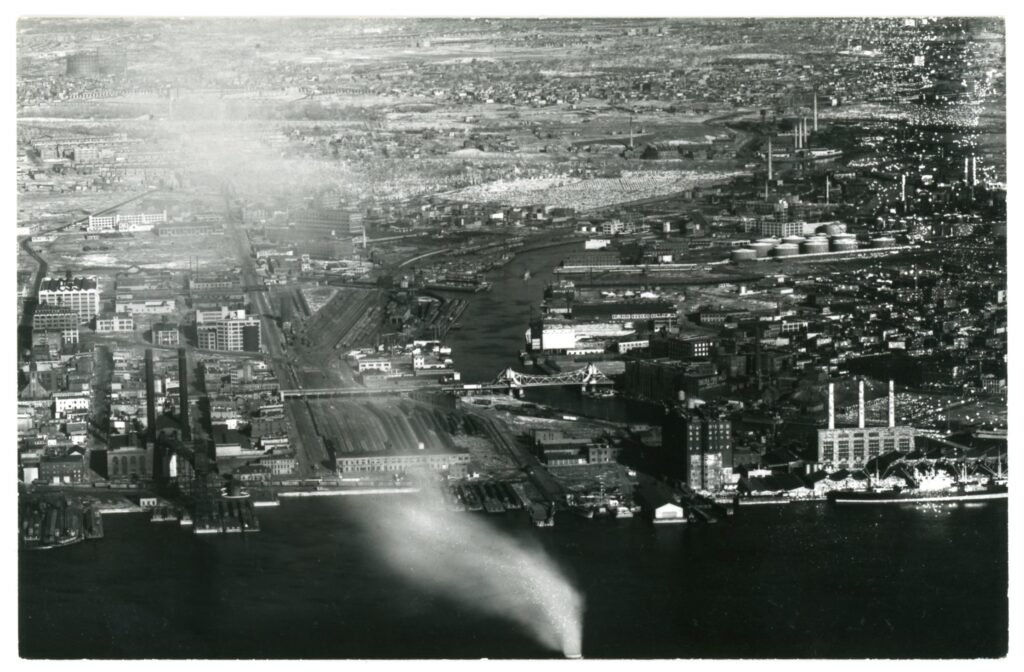
Unidentified photographer. [Aerial view of Long Island City, Queens, and Greenpoint, Brooklyn] ca. 1930s. Gift of Norman Brouwer, South Street Seaport Museum 1998.002.0394
Brothers Captain Frederick Russell (1853–1945) and Captain John Russell (1855–1931) had founded Newtown Creek Towing Company (NCTC) in 1880 to manage ownership of their fleet of tugboats, merging with a few other companies through the years and acquiring additional craft.[4]“I.C.C. Clears M’Allister Merger with Russell Bros. Towing Co.,” New York Times, November 7, 1962. The business was incorporated nine years later.[5]“Newtown Creek Towing Company,” Brooklyn Eagle, January 28, 1889. They were highly invested in the movement on this waterway for their livelihood and were very much in favor of its $300,000 dredging being demanded in 1896. John Russell declared an insufferable monitoring and adherence to tides for scheduling tows and $11,000 in damages to their boats incurred as a result of groundings and other incidents, due to its shallow depths.
Russell Brothers Towing Company had existed since at least 1908, handling the chartering and operations of the fleet.[6]“Tugboat Burns in Newtown Creek,” New York Times, November 30, 1908. It was incorporated in 1923, and sometime in the 1920s, they acquired the approximately decade-old Liberty Dry Dock at the foot of Quay Street on the Bushwick Inlet in Greenpoint from its founder James A. O’Boyle. Their brother, Hilary F. Russell, was appointed President. Subsequent tugs added to the fleet therefore could be built by the Russells themselves in addition to those bought from other owners.[7]“Liberty Dry Dock,” Builders Who Have Been Inactive Since WWII, U.S. Builders of Small Vessels, Shipbuilding History. Russell Dry Dock Company, builders of W. O. Decker, would have existed before 1930, but further information will need to be investigated concerning its origins.[8]This exact company name so far brought up no search results in the available digitized history of the New York Times or concurrent press. The only appearance of it was the 1932 War Department map … Continue reading
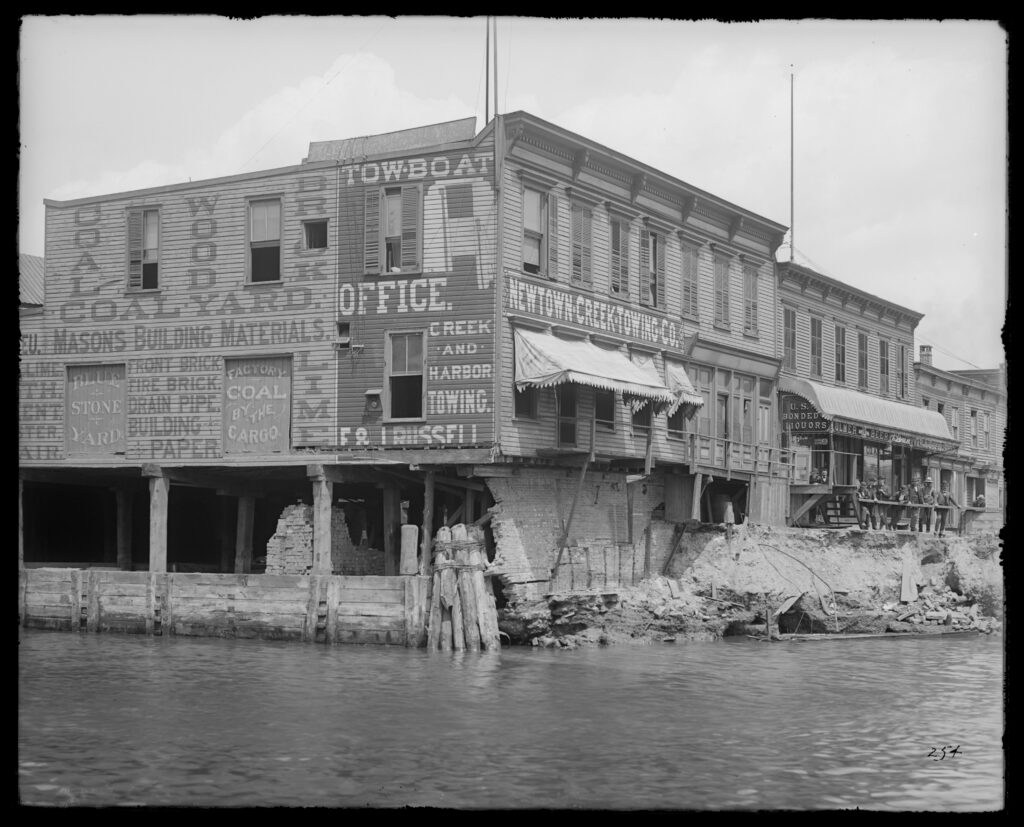
“Office Newtown & Towing Company from old center pier span” July 15, 1903. Courtesy of Municipal Archives, City of New York.
The family’s operations were said to be some of the largest in the area.[9]“Capt. Russell Dies,” New York Times, October 27, 1945. They in part controlled Russell, Poling & Company, maintaining a fleet of their own barges, some of which were named for the company and numbered. Barges were typically owned by the companies loading them to be shipped so they could better suit the idiosyncrasies of a particular type of cargo––solid or liquid, for one important distinction. The Russells controlling their own declares the expansiveness of their investments. Yet more businesses found to be associated with the family included Newtown Towing Line, Russell Brothers Transport Company, Newtown Creek Towing Baltimore[10]“Ship Owners Indicted,” New York Times, November 19, 1941., and Tice Towing Line, Incorporated. They primarily dealt with the transport of oil, coal, stone, brick, metal scrap, and railroad cars.[11] “Two Unions Fought by Towing Company,” New York Times, June 24, 1936.
They also came to own a fleet of steamboat pleasure craft. They were operating their own foundry in 1895, which by 1930 was known as the Long Island Machine and Marine Company (LIMM), likely located at what is now 509 48th Avenue.[12]No borough needed. Roadways on the Queens side are numbered–aside from major arteries like Vernon Boulevard, etc.––on the Brooklyn side they’re named for important local personalities. What … Continue reading Decker was said to be the last vessel built at LIMM, likely referring to her steam engine and other machinery, if not her hull.
Their tugboat fleet consisted of eleven vessels in 1892. This had grown to twenty-one of them regularly scheduled in 1924, with four or five spares available.[13]Newtown Creek Towing Co. v. City of New York, 23 F.2d 486 (2d Cir. 1928). Then the fleet apparently diminished over time, but it was reportedly fairly common for towing companies to be constantly buying and selling vessels back and forth. It had fallen to nineteen by 1936, and by 1954 to fourteen––half of them ocean-going––along with nineteen barges. Four years later it had dwindled to twelve[14]“A ‘Converitble’ Tug for Russell,” Marine Engineering/Log, October 1, 1958., down to ten when their companies were sold in 1962.
Showboats
A few of the Russells’ vessels commanded special attention being launched with some amount of fanfare no doubt purposely intended to attract press and industry interest.
There are discrepancies regarding the J. Raymond Russell, but she was probably an 87.5-foot 525-horsepower diesel-powered tug built at their own Liberty Dry Dock and added to the fleet in 1939.[15]“Events of Interest in the Shipping World–New Tugboat Exhibited,” New York Times, April 30, 1939. However, a collision involving the vessel in 1942 shows her measured at 78.5-feet long.[16]Peterson Light. Tow. v. The J. Raymond Russell, 87 F. Supp. 467 (S.D.N.Y. 1949). She was evidently still in operation in early 1943.[17]Poling Russell, Inc. v. United States et al., 97 F. Supp. 649 (S.D.N.Y. 1951). The Raymond––named for John Raymond Russell (1894–1938), the recently deceased younger brother of Frederick and John––was likely intended to be something of a flagship, launched less than a month after the opening of the 1939 World’s Fair. She was put on display off the Battery, attracting press. She was sleek and squat, with a short stack to accommodate the low clearances of canal work, and used water for ballast so her draught could change quickly in response to their shallow tidal depths.[18]One hopes this was demonstrated for industry visitors like a low-rider Chevy Impala bouncing on hydraulic suspension. She had a Westinghouse radio system that enabled shore stations to call her directly, rather than addressing all the vessels on the creek at once.
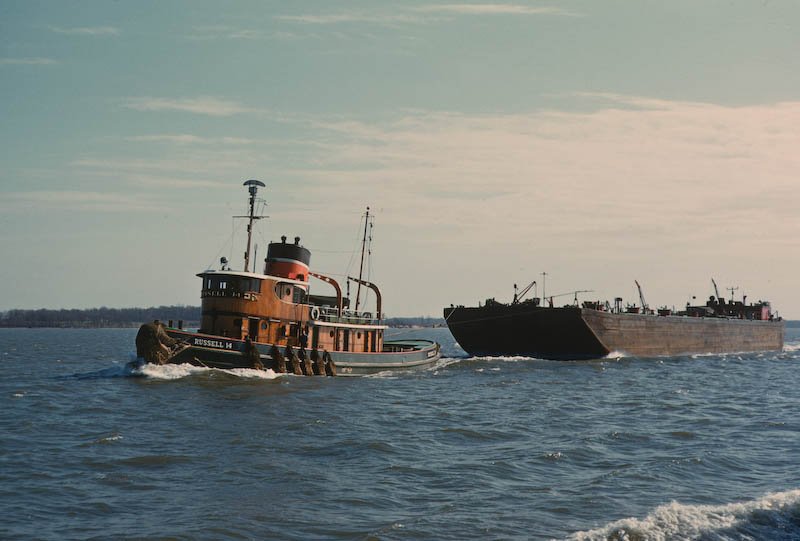
The Russell No. 14 was apparently the brothers’ own private conveyance, built in 1952 by their Liberty Dry Dock. The 1050-hp tug featured a somewhat unusual, mahogany-paneled “owner’s lounge” with a bar-shaped counter to entertain prospective clients. President Warren Russell said it was more common in the early days of tugboating for the owner to have his own room, but had since become less so.
Designed by Naval Consultant Townsend J. Smith for harbor, Great Lakes, and offshore work, she also featured a deep freeze and sufficient stores to feed a crew of twelve for thirty days in operation. By this time, evidently, Liberty Dry Dock was no longer building new craft aside from this special order, but concentrated more on maintenance and repair of the fleet.
Image from the Edward O. Clark Collection, Steamship Historical Society Archives, www.sshsa.org
In 1958 they launched the Russell No. 10, designed by Naval Architect Merritt Demarest. She was considered innovative due to a hydraulic “convertible” wheelhouse, which could be left in its raised position to allow for greater visibility over barges, or lowered to handle shorter clearance under canal bridges. Similarly, her mast, davits, and radar antenna were hinged and could be easily lowered. This technologically advanced vessel tragically sank in 1984, and is now marked by buoy WR-28 near Norwalk, Connecticut.[19]“A ‘Converitble’ Tug for Russell,” Marine Engineering/Log, October 1, 1958.
And finally, our very own…
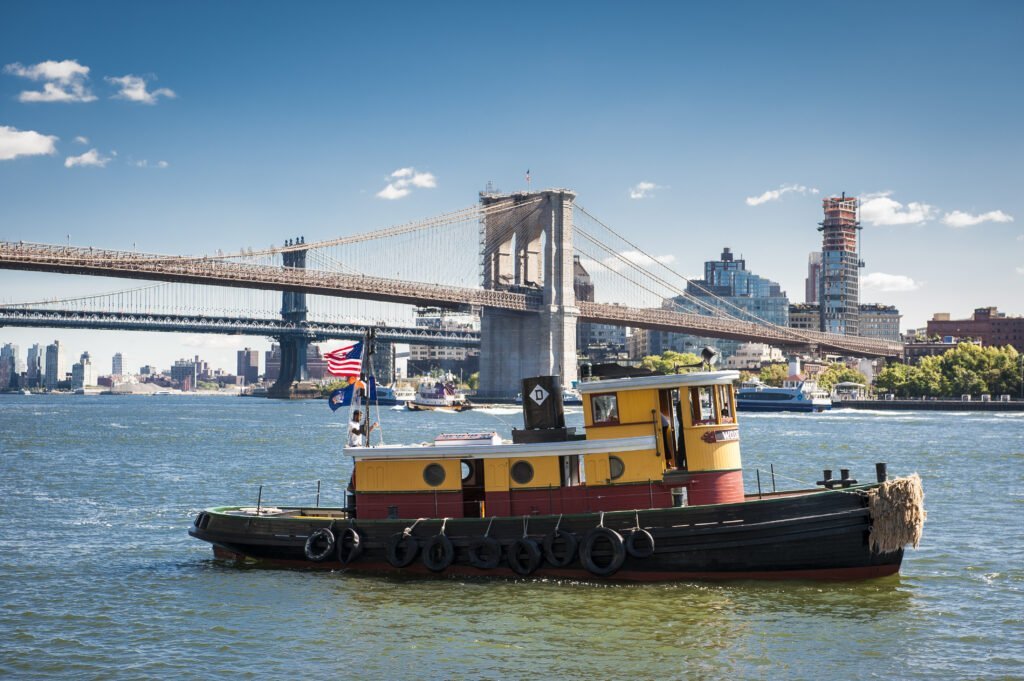
W.O. Decker, 2021. Photo credit Richard Bowditch.
The building of 52-foot W. O. Decker was most likely ordered to keep shipyard workers occupied during the Depression. She was cobbled together with an odd mixture of parts. A wooden hull was sadly out of date in the age of steel, she had a coal-fired 75-hp compound steam engine when oil-fired engines had become commonplace, and had oddly big porthole windows much better suited to a larger vessel.[20]Observations thanks to Jesse Lebovics, Director of Historic Ships, South Street Seaport Museum.
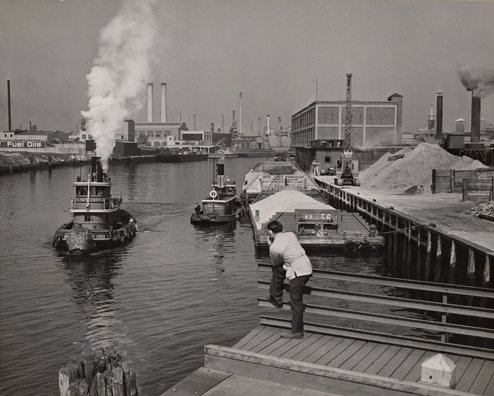
Ralph J. Russell (1902–1957) was named master carpenter on the build. Referred to as a “Creek Tug,” she would have worked mostly inside Newtown Creek itself, with some harbor work, rather than longer-distance runs.
In 1946 she was sold to Oscar & Mary Decker, converted from steam to a 285-hp General Motors 6-110 Diesel Engine, and renamed for Oscar’s father William Oscar Decker.
Apparently the conversion to diesel was the reason for the Museum retaining this name of W. O. Decker, rather than considering her to be the steam-powered Russell No. 1.
Alexander Allan, photographer. “Newtown Creek – [Industrial plants along Queens and Brooklyn shores.]” 1939. Irma and Paul Milstein Division of United States History, Local History and Genealogy, The New York Public Library.
For the Deckers, she worked Arthur Kill, mostly towing materials for construction of the New Jersey Turnpike, the first leg of which was completed in 1951. This vehicular artery followed the Arthur easily, in the same way that railroad lines also commonly followed existing waterways. Alternate shipping methods converged on these routes not only to complement and compete with existing transportation business, but the centers of trade were already established along these routes.[21]Possibly the most spectacular manifestation of this convergence is at 42nd Street and Park Avenue, where meets the bejeweled, apocryphal beating heart of rail travel, Grand Central Terminal; the most … Continue reading
In 1967, Decker was sold to George Rogers Construction Company, retaining her name, but remained with the company only a year before being sold to the Youghiogheny and Ohio Coal Company. The new owners renamed her Susan Dayton, and she went back to towing coal barges. Only four years later, she was sold yet again to Dock Incorporated in Stratford, Connecticut, who kept her name Dayton.
George Matteson, interested in protecting historic ships, purchased her via “Tug W. O. Decker, Incorporated” in 1978. In return for berthing privileges, Matteson allowed the Seaport Museum to use her to shift around its fleet of ships.
Today, Decker remains a beloved member of the Museum fleet, a platform for educating visitors about New York’s maritime and industrial history. On weekends during the warmer months, she takes passengers into the harbor for views of the Lower Manhattan skyline and Statue of Liberty and to experience her running.
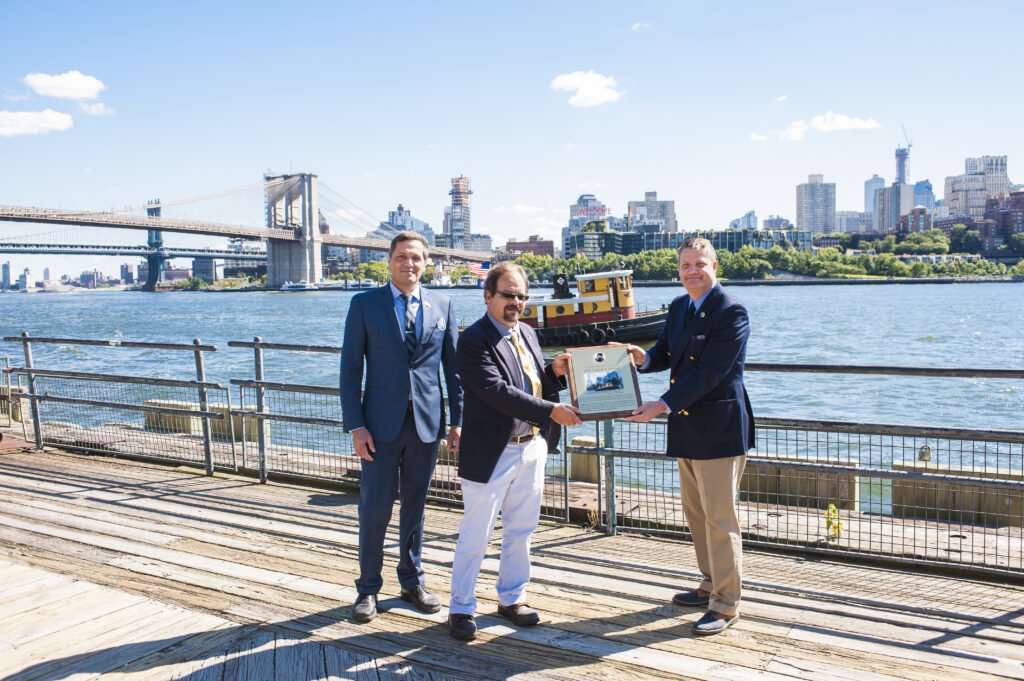
W.O. Decker received the “Tugboat of the Year” award by the Steamship Historical Society of America in 2021. SSHSA Vice President Pat Dacey presents the award to Capt. Jonathan Boulware, Seaport Museum’s President and CEO, and Jesse Lebovics, Seaport Museum’s Director of Historic Ships. Photo credit Richard Bowditch.
Additional Readings and Resources
Tugboats and Shipyards: The Russells of New York Harbor, 1844–1962, by Hillary Russell, Jr., 2019.
Historic 1930 Tug ‘W. O. Decker’ Visits Hudson River Maritime Museum, published on the Hudson River Maritime Museum’s History Blog, 2020.
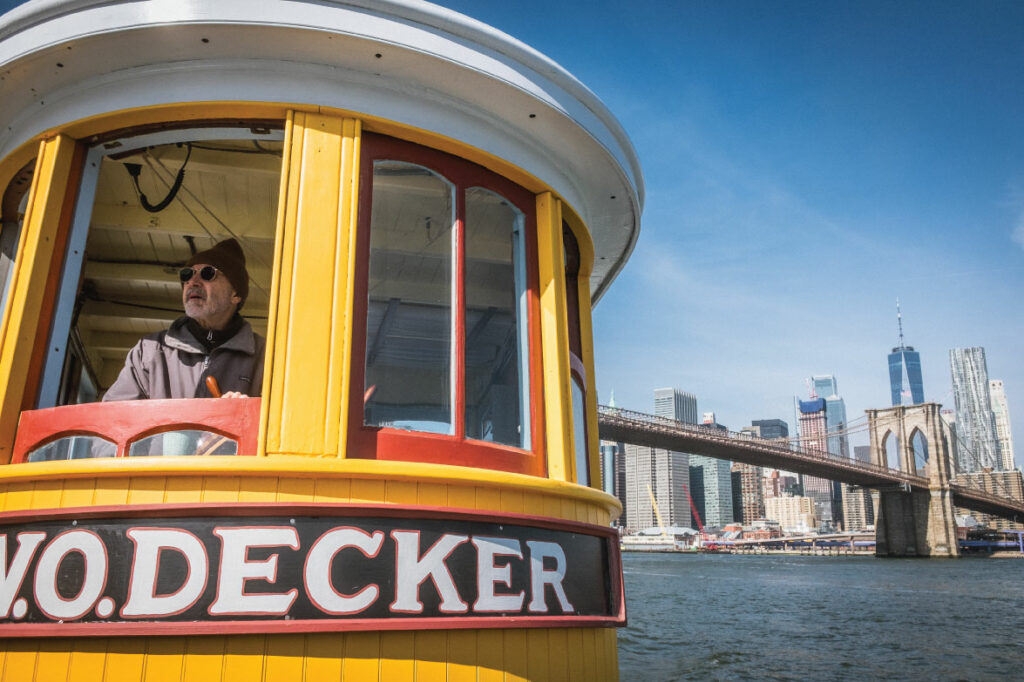
Education Programs on W.O. Decker
W.O. Decker is available for educational programs middle school high school university, smaller groups, especially good for marine science studies or and getting close to various habitats and the working waterfront.
References
| ↑1 | “Artwork: ‘Hook,’ ‘Line,’ and ‘Sinker,’” Subway Art Guide, Line by Line Guide, NYCSubway. |
|---|---|
| ↑2 | Flyer: “The Newtown Creek Nature Walk,” NYC Department of Environmental Protection |
| ↑3 | Note should be made of SWA Group’s masterpiece Hunter’s Point South Waterfront Park, approaching from the Queens side. |
| ↑4 | “I.C.C. Clears M’Allister Merger with Russell Bros. Towing Co.,” New York Times, November 7, 1962. |
| ↑5 | “Newtown Creek Towing Company,” Brooklyn Eagle, January 28, 1889. |
| ↑6 | “Tugboat Burns in Newtown Creek,” New York Times, November 30, 1908. |
| ↑7 | “Liberty Dry Dock,” Builders Who Have Been Inactive Since WWII, U.S. Builders of Small Vessels, Shipbuilding History. |
| ↑8 | This exact company name so far brought up no search results in the available digitized history of the New York Times or concurrent press. The only appearance of it was the 1932 War Department map included in the Hilary Russel text (p.41). It should be noted that Hilary also records Russell No. 1 as built at Liberty Dry Dock (p.45). |
| ↑9 | “Capt. Russell Dies,” New York Times, October 27, 1945. |
| ↑10 | “Ship Owners Indicted,” New York Times, November 19, 1941. |
| ↑11 | “Two Unions Fought by Towing Company,” New York Times, June 24, 1936. |
| ↑12 | No borough needed. Roadways on the Queens side are numbered–aside from major arteries like Vernon Boulevard, etc.––on the Brooklyn side they’re named for important local personalities. What this contrast says about the differences between the two are as far reaching as politics and religion. |
| ↑13 | Newtown Creek Towing Co. v. City of New York, 23 F.2d 486 (2d Cir. 1928). |
| ↑14, ↑19 | “A ‘Converitble’ Tug for Russell,” Marine Engineering/Log, October 1, 1958. |
| ↑15 | “Events of Interest in the Shipping World–New Tugboat Exhibited,” New York Times, April 30, 1939. |
| ↑16 | Peterson Light. Tow. v. The J. Raymond Russell, 87 F. Supp. 467 (S.D.N.Y. 1949). |
| ↑17 | Poling Russell, Inc. v. United States et al., 97 F. Supp. 649 (S.D.N.Y. 1951). |
| ↑18 | One hopes this was demonstrated for industry visitors like a low-rider Chevy Impala bouncing on hydraulic suspension. |
| ↑20 | Observations thanks to Jesse Lebovics, Director of Historic Ships, South Street Seaport Museum. |
| ↑21 | Possibly the most spectacular manifestation of this convergence is at 42nd Street and Park Avenue, where meets the bejeweled, apocryphal beating heart of rail travel, Grand Central Terminal; the most heartbreakingly beautiful and sophisticated monument to automobile culture, the Chrysler Building; and the futuristic corporate behemoth Pan American Airlines controversy with its enormous logos and deadly helipad serving JFK Airport at the roof. |

